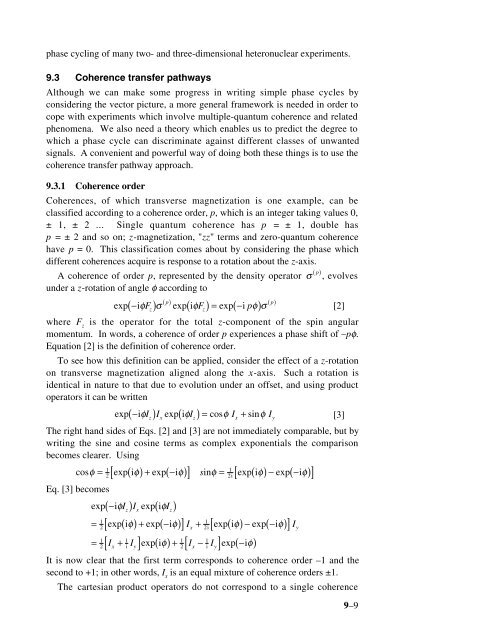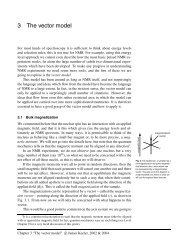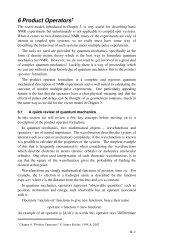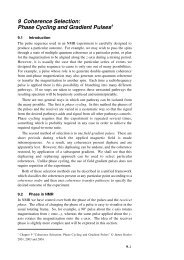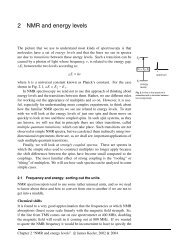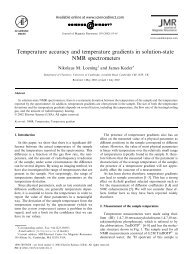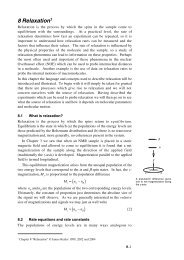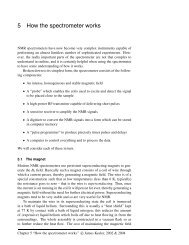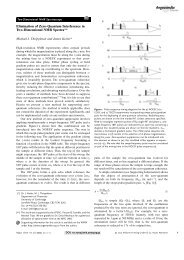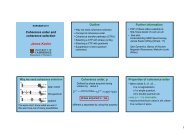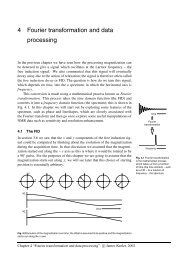Phase Cycling and Gradient Pulses - The James Keeler Group
Phase Cycling and Gradient Pulses - The James Keeler Group
Phase Cycling and Gradient Pulses - The James Keeler Group
You also want an ePaper? Increase the reach of your titles
YUMPU automatically turns print PDFs into web optimized ePapers that Google loves.
phase cycling of many two- <strong>and</strong> three-dimensional heteronuclear experiments.<br />
9.3 Coherence transfer pathways<br />
Although we can make some progress in writing simple phase cycles by<br />
considering the vector picture, a more general framework is needed in order to<br />
cope with experiments which involve multiple-quantum coherence <strong>and</strong> related<br />
phenomena. We also need a theory which enables us to predict the degree to<br />
which a phase cycle can discriminate against different classes of unwanted<br />
signals. A convenient <strong>and</strong> powerful way of doing both these things is to use the<br />
coherence transfer pathway approach.<br />
9.3.1 Coherence order<br />
Coherences, of which transverse magnetization is one example, can be<br />
classified according to a coherence order, p, which is an integer taking values 0,<br />
± 1, ± 2 ... Single quantum coherence has p = ± 1, double has<br />
p = ± 2 <strong>and</strong> so on; z-magnetization, "zz" terms <strong>and</strong> zero-quantum coherence<br />
have p = 0. This classification comes about by considering the phase which<br />
different coherences acquire is response to a rotation about the z-axis.<br />
A coherence of order p, represented by the density operator σ ( p)<br />
, evolves<br />
under a z-rotation of angle φ according to<br />
( ) ( )= ( − )<br />
( ) ( )<br />
p<br />
p<br />
exp −iφFz<br />
σ exp iφFz<br />
exp ipφ σ<br />
[2]<br />
where F z<br />
is the operator for the total z-component of the spin angular<br />
momentum. In words, a coherence of order p experiences a phase shift of –pφ.<br />
Equation [2] is the definition of coherence order.<br />
To see how this definition can be applied, consider the effect of a z-rotation<br />
on transverse magnetization aligned along the x-axis. Such a rotation is<br />
identical in nature to that due to evolution under an offset, <strong>and</strong> using product<br />
operators it can be written<br />
( ) ( )= +<br />
exp −iφI I exp iφI cosφ I sinφ<br />
I<br />
z x z x y [3]<br />
<strong>The</strong> right h<strong>and</strong> sides of Eqs. [2] <strong>and</strong> [3] are not immediately comparable, but by<br />
writing the sine <strong>and</strong> cosine terms as complex exponentials the comparison<br />
becomes clearer. Using<br />
[ ( )] =<br />
2i<br />
( )− ( − )<br />
[ ]<br />
1<br />
1<br />
cosφ = exp( iφ)+ exp −i φ sinφ exp iφ exp iφ<br />
Eq. [3] becomes<br />
2<br />
( z) x ( z)<br />
( )<br />
exp −iφI I exp iφI<br />
[ ] + [ ( )− ( − )]<br />
1<br />
1<br />
=<br />
2<br />
exp( iφ)+ exp −iφ Ix<br />
2i<br />
exp iφ exp iφ<br />
I<br />
1 1 1 1<br />
=<br />
2 [ Ix +<br />
i<br />
Iy] exp( iφ)+ 2 [ Ix −<br />
i<br />
Iy] exp( −iφ)<br />
It is now clear that the first term corresponds to coherence order –1 <strong>and</strong> the<br />
second to +1; in other words, I x<br />
is an equal mixture of coherence orders ±1.<br />
<strong>The</strong> cartesian product operators do not correspond to a single coherence<br />
y<br />
9–9


